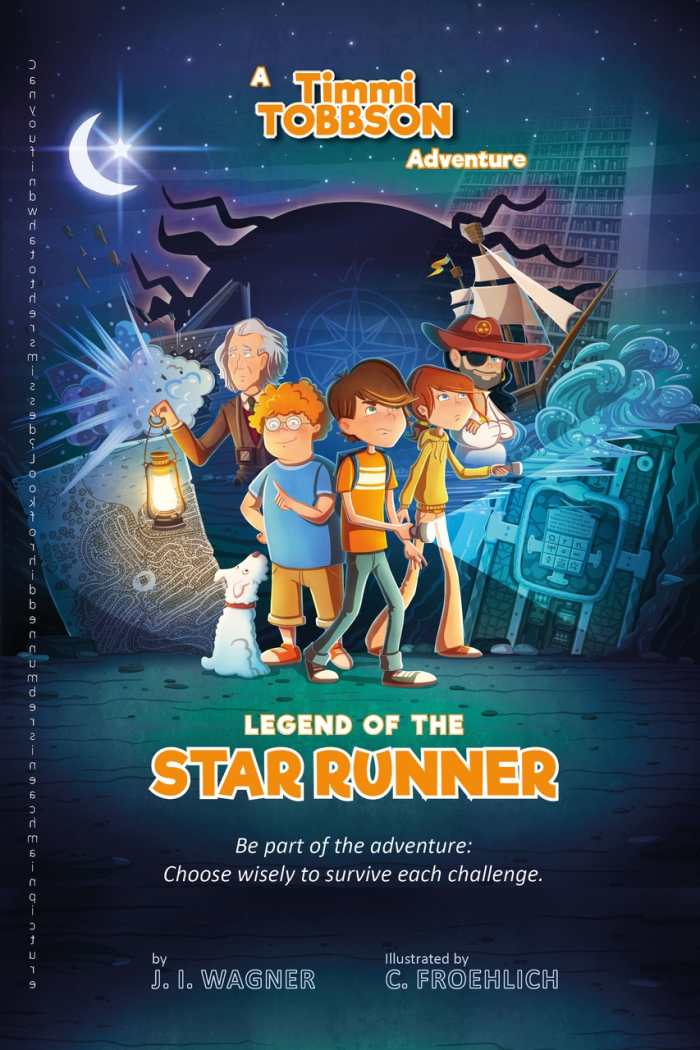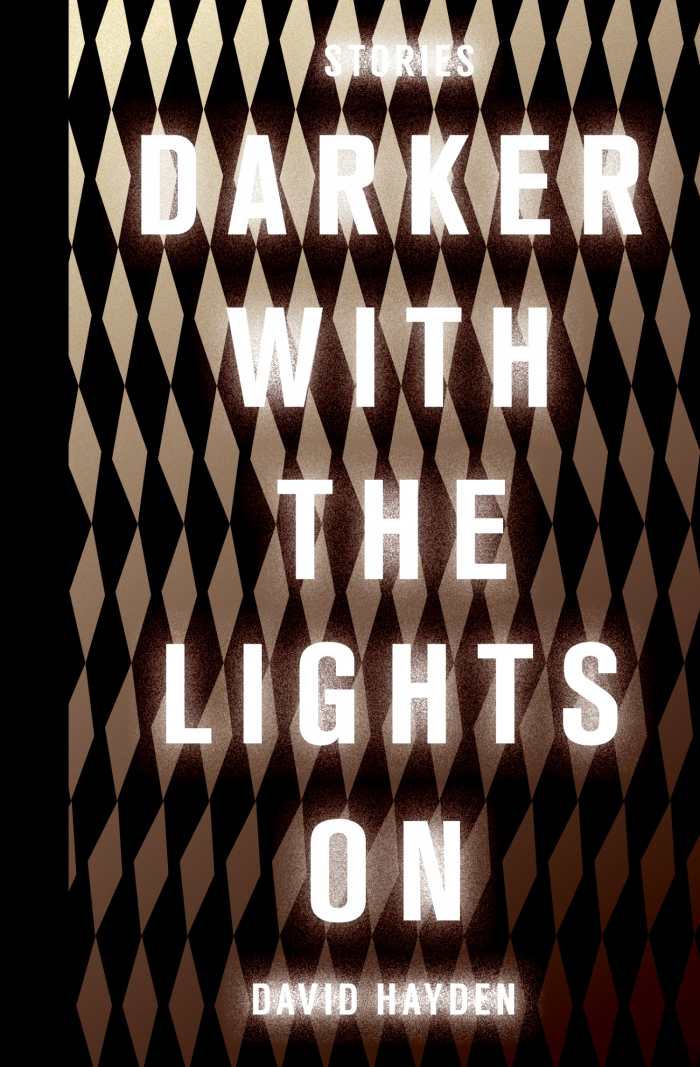Book of the Day Roundup May 21-May 25

Legend of the Star Runner
A Timmi Tobbson Adventure

J. I. Wagner
Cindy Froehlich, illustrator
freshabooks
Softcover $12.99 (168pp)
978-3-96326777-2
Buy: Local Bookstore (Bookshop)
A spirited trio of kid sleuths undertake a classic treasure hunt in J. I. Wagner’s Legend of the Star Runner. Taking its inspiration from video games and cloak-and-dagger mysteries, this story for middle-grade readers is a visual feast.
Lilli’s grandfather is facing eviction. With the prospect of a pirate’s treasure guiding them, she and her best friends, Marvin and Timmi, set out to find the loot to rescue him from his debts. A large-hearted, naïve, and wildly improbable plot delights as the fearless team—led by a treasure hunter—lands in a series of underground worlds.
Several twists and turns hinge on pure luck, timing, and uncanny perceptions. A reliance on video-game staples, including hidden passageways, trapdoors, puzzles, maps, and multiple-choice paths, sometimes threatens to turn the book into a high-concept maze. Still, what the story misses in the depth of its background, the illustrations make up for; they are smart compositions using chromatic palettes and feature clues. From a cluttered kitchen to the check-in desk at the Savoy to a wall of keys at an archive, scenes set a distinct mood for the story.
The tone is wisely calibrated; it’s neither overly terrifying nor overly lighthearted. The perils the group encounter pose enough danger to build suspense yet leave room for escape. There’s seldom doubt that the kids will prevail, considering their Holmesian knack for observation; the book’s pleasure rests in their citywide ranging that peels back history to reveal the secrets of a legendary pirate embedded in their midst.
A list of fun facts lists the book’s film influences, which include Pirates of the Caribbean, and a section of hints offers insights written in reverse. With the exuberance of a caper, determined protagonists, and a message steeped in family legacy, this first in a planned series is a splendid homage to adventure.
KAREN RIGBY (April 27, 2018)
Little Beast

Julie Demers
Rhonda Mullins, translator
Coach House
Softcover $16.95 (148pp)
978-1-55245-366-7
Buy: Local Bookstore (Bookshop)
Vigorously potent, Little Beast haunts the intersection of fairy tales with gritty realism.
When a full beard emerges on a nameless eleven-year-old girl’s face, she and her mother conceal the development from judgment in their tiny Quebecois mountain village. But several villagers, including the mayor and the priest, inevitably discover their strange situation, and the girl flees before she can be attacked out of sheer superstition.
In the solitude of the surrounding woods, she navigates hazards and relishes the beauty of nature. A chance encounter with a pair of hunters and their captured bear forces her to reconsider her path.
The protagonist drifts through the Canadian woods like a wraith. A magical quality infuses her inner monologue; it is borderline stream of consciousness at times. There is an appropriate childlike innocence to her musings, even in the face of death and human corruption. Rhonda Mullins renders the lyricism well in her translation, resulting in prose that is both tight and enticing.
Underlying the concrete details of the village, the mountain forest, and the human hunters who cross the girl’s path is a gentle surrealistic note. Amid mundane trappings, fantastical elements reside. The girl is on a self-imposed quest—not to find some powerful object or defeat a great evil, but to solve the puzzle that is herself, whiskers and all, and to reconcile herself to the rest of world.
As she wrestles with the insincerity and cruelty of humanity, she finds that she cannot exist in isolation forever. Despite the odiousness she observes in the hunters and the faults she recalls in her mother, she recognizes that others are a necessity. It is in relationships, no matter the kind, that growth is found.
Little Beast is a fierce yet subtle foray into the interplay of fantasy and reality, proving that great profundity can sometimes be found in small—and bearded—girls.
MEAGAN LOGSDON (April 27, 2018)
Mother of Invention

Caeli Wolfson Widger
Little A
Hardcover $24.95 (363pp)
978-1-5039-5007-8
On its surface, Mother of Invention is a quasi-feminist speculative novel about reinventing the way that women give birth. In her forties and childless only partially by choice, Tessa, a biotech whiz, finds the prospect of shortening gestation periods and easing women’s ways into motherhood to be irresistible.
Below the hopeful progressions of her company’s experiment, though, dark secrets lurk. Audience misgivings will be as slow to rise as the truth is to reveal itself to the well-meaning pioneers of Caeli Wolfson Widger’s horrifying near-future venture.
Characterizations bloom outward, from the safest and scientific circles to the subjects upon whom they build their work. Tessa is constructed as tough, wealthy, and sympathetic, always straining for more freedom than her choices allow. Her corner-cutting business partner, Luke, is less concerned with birthing a feminist revolution than he is with personal glory. Unbeknownst to him, it’s notoriety he’s edging toward, not fame, all because of his fixation on a group of children born in nine weeks instead of nine months.
Are they a fluke? An evolutionary twitch? Engineered? As the shadow victims of accelerated gestation reveal themselves—most noticeably in Irene, a former Yale student now locked in limbo in a government facility, and Vivian, who cannot stop talking about her unique origins—major ethical questions arise, coloring the text in time with its most thriller-like revelations, including the fascistic operations of a “Washington outsider” American president and his jaded operative, once lulled into service by “the promise of surveillance.”
The text isn’t perfect. A few details are garbled or awkward, scenes are set with a bit too much sparkling sunlight, the ending is anticlimactic, and questions may emerge—Would a woman like Tessa really approve a project name like TEAT? Will fidget spinners still be a thing in 2021?—but the story’s broader developments will still hold readers rapt. Mother of Invention cleaves together the nightmare and dream scenarios of technological advancement.
MICHELLE ANNE SCHINGLER (April 27, 2018)
Two Lives

Reeve Lindbergh
Brigantine Media
Softcover $14.95 (136pp)
978-1-938406-70-6
Reeve Lindbergh’s family was in the public eye again and again during the twentieth century. In her memoir Two Lives, she reveals personal memories of her parents, the controversial aviator-authors Charles A. and Anne Morrow Lindbergh. Through delightful essays on the nuances of caring for chickens and dealing with the overwhelming family archives that are scattered throughout the country, Lindbergh skillfully reveals tidbits about what it was like growing up in her family, while also confronting broader themes like death and memory.
Addressing her family’s controversies is perhaps unavoidable, but Lindbergh successfully uses Two Lives primarily as an exploration of the simpler pleasures of her life on a Vermont farm, like her favorite rooster soup and her husband’s fascination with trees. This makes for a surprisingly charming memoir about cycles of time, the calm certainty of death for roosters and people alike, and the joys of home cooking.
Seeing Charles Lindbergh through his daughter’s eyes is fascinating. He is at once a decorated innovator and someone who failed out of college. He is a father grieving his son’s gruesome death, and also someone who secretly had mistresses and other children. Lindbergh tells her story as only she could, remaining acutely aware of her family’s faults, but also with a certain unconditional warmth.
Though some topics may appear innocuous, Lindbergh uses them as jumping-off points to tell stories packed with complexity. In one compelling chapter, “Remnants and Recipes,” she hints at her feelings towards her father, blaming him for the addition of canned soup into her mother’s hearty recipes. Yet the appeal of the book is not just the Lindbergh enigma, but also how Reeve revels in memories of eating “ladylike” lunches with her mother, or the nostalgia and laughable disgust of finding odd recipes like “Souper Baked Chicken” among her mother’s things.
The memoir shifts between subjects quickly and seamlessly, weaving the intensely personal and the mundane with charming finesse. The prose has depth while maintaining lightness. Two Lives is an engrossing memoir.
PAIGE VAN DE WINKLE (April 27, 2018)
Darker with the Lights On

David Hayden
Transit Books
Softcover $15.95 (224pp)
978-1-945492-11-2
Buy: Local Bookstore (Bookshop)
From ambiguousness to garish nightmares, David Hayden gleans incidents from the lives of characters standing at the abyss. Darker with the Lights On tunes in to a fascinating, eerie frequency and is surprising at every turn.
These visceral stories test the line between the grotesque and the cunning with their clinical portrayals of troubled characters. A man whose wife is gone spends his days considering objects. A corpse decomposes on a table while dinner guests treat the gruesome tableau as a matter of course. An abusive man narrates his story after having been murdered. Another man falls from a building, setting the stage for an experiment in suspended time. Despite their foreboding, these stories are otherworldly rather than shocking—a mark of their careful, calibrated style.
With minimal background on the characters, what matters is the particular encounter which, once it has passed, leaves further aftershocks in its wake. The effect is jarring and startling, a risk that takes themes of isolation, memory, and loss and turns them into questions with few answers. Amid the strangeness, everything familiar strikes a deep chord. As difficult as some of these characters are, their wishes to be heard ring above their circumstances.
Many of the stories relish in theatrics. They’re often set in claustrophobic surroundings that unfold in fecund descriptions. They focus on distinct scenes. Sometimes—as in the haunting “Elsewhere”—they convey a powerful sense that tragedy has taken place just off stage.
Less brutal stories provide respite from the violence while still displaying an impressive range. These include flash fiction that considers the moment just after an outing at the theater, an allegory in which a man seeks nourishment in a library, and a tall tale on the plight of miners who can’t stop crying.
Darker with the Lights On is a rich, demanding collection whose stories illuminate dark corridors where what’s visible is more frightening than what can only be imagined.
KAREN RIGBY (April 27, 2018)
Hannah Hohman
